Text
Navigating the Path to Front-End Mastery: A Guide for HTML/CSS/JavaScript Enthusiasts
Are you someone who is eager to advance in your web development career and is already conversant with HTML, CSS, and JavaScript? Well done on making it this far! Let's now set a path to help you become a skilled front-end developer.
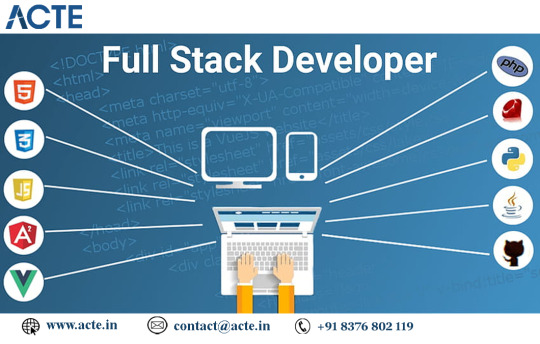
1. Master the Fundamentals
Make sure you have a strong foundation before tackling more complex ideas. Expand your knowledge of CSS layouts, JavaScript fundamentals, and HTML semantics. This guarantees a solid understanding of the resources available to you.
2. Responsive Design and Cross-Browser Compatibility
Discover how to create responsive designs. Make sure your webpages look great on all types of devices by learning how to use CSS media queries. Explore cross-browser compatibility as well to guarantee a consistent user experience across different browsers.
3. Using Git for Version Control
Git is a very useful tool for team development. Discover the fundamentals of version control to keep track of changes, collaborate easily, and protect your work. GitHub and GitLab are two platforms that can be great places to start.
4. CSS preprocessors, such as LESS and SASS
Investigate preprocessor languages like SASS or LESS to improve your CSS skills. They improve the efficiency and maintainability of your stylesheets by adding variables, functions, and mixins.
5. Master a Front-End Framework (e.g., React, Vue, Angular)
Nowadays, front-end frameworks form the foundation of online development. Select one and go in-depth with it. Angular, Vue, and React are well-liked options. It is crucial to comprehend how to create and manage a project using these frameworks.
6. Understand build tools (e.g., Webpack).
Effective building procedures are becoming more and more necessary as your projects expand. You can bundle your code, optimize assets, and improve performance with the aid of tools like Webpack. Learn how to use these tools effectively to optimize your development process.
7. Learn Basic Back-End Skills
Although it's not required, having a foundational understanding of back-end technologies (such as Node.js, Express, Django, etc.) might help you become a more versatile developer. You'll work with back-end engineers more productively and comprehend the entire stack.
8. Explore AJAX and APIs.
It's essential to know how to retrieve and work with data. Develop your understanding of APIs and AJAX (asynchronous JavaScript and XML) to build dynamic, interactive websites.
9. Testing and Debugging
Develop your ability to test your code. Examine JavaScript testing tools such as Jest. Plus, learn how to debug effectively to solve problems quickly.
10. Continuous Learning
The tech industry is changing quickly. Keep your mind open to picking up new skills, resources, and best practices. Read blogs related to the industry, take part in forums, and attend meetups or conferences to stay on top of the latest trends.
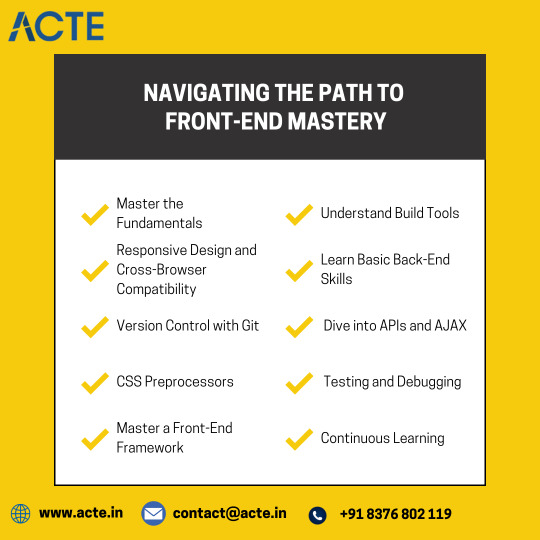
The path to becoming a front-end developer is never-ending. Take on new tasks, construct genuine initiatives, and never forget that it's acceptable to go one step at a time. Even if the path ahead may seem convoluted, if you have a strong will and a desire to study, you may become an accomplished front-end developer. Have fun with coding!
if you're interested in learning more about full-stack developers because it provides opportunities for certification and job placement. Skilled educators can improve your learning. These services are available both offline and online. Take it step by step, and if you're interested, think about signing up for a course.
Thank you for spending your valuable time, and have a great day.
0 notes
Text
Building Blocks of a Website: A Simple Guide to Website Development
Although starting a website may seem like a difficult undertaking, have no fear! In this blog article, we'll simplify and make it easier to grasp the website-building process. Let's examine the fundamentals of making your website work, regardless of your level of experience or whether you need a refresher.

1. Define Your Purpose and Audience:
It's important to decide who your target audience is and what your website's goal is before getting too technical. Are you making a portfolio, a blog, or an online store? Making decisions on design and development will be guided by your goals.
2. Choose a domain name and hosting:
The first step in creating a website is choosing a hosting company and a domain name, or web address. To make sure that people can reach your website, pick a domain name that accurately describes your brand or content and a reputable hosting provider.
3. Plan Your Website Structure:
Consider your website to be a book. Make a plan for the primary sections (pages) and their arrangement. Home, About Us, Services and Products, and Contact are examples of common pages. This planning stage helps in creating a user-friendly navigation structure.
4. Website Design:
Let's now work on creating a visually pleasing website. Either use website builders and templates, or engage a designer. Look for fonts, color schemes, and imagery that complement your brand and draw in customers.
5. Front-end coding (JavaScript, HTML, CSS):
What users view and work with is known as the front end. Your material is structured using HTML (Hypertext Markup Language), styled using CSS (Cascading Style Sheets), and interactive with JavaScript. Frameworks such as React or Vue. JS are widely used in current websites to simplify front-end development.
6. Create the server, database, and server-side language on the back end:
Your website's functionality is powered by the backend. This entails configuring a server, selecting a database (such as MySQL or MongoDB), and handling data and background tasks with server-side languages (such as Node.js, Python, or PHP).
7. Integrate Functionality (APIs, Plugins):
Use APIs (application programming interfaces) or plugins if your website requires additional functionality, such as payment gateways or social network integration. These tools make it possible for your website to easily communicate with outside services.
8. Test Your Website:
Test your website thoroughly before launching to identify any faults or difficulties. Verify that all of the features function as expected by checking how responsive it is across a range of browsers and devices.
Your website's functionality is powered by the backend. This entails configuring a server, selecting a database (such as MySQL or MongoDB), and handling data and background tasks with server-side languages (such as Node.js, Python, or PHP).
9. Search Engine Optimization (SEO):
By making your website search engine-friendly, you may increase its visibility. This entails making sure your material is easily available to search engine crawlers, employing relevant keywords, and developing descriptive meta tags.
10. Go Live with Your Website:
Best wishes! You're prepared to take off! After you link your domain to your hosting, your website will go live and be available to everyone.

Planning, designing, coding, and testing are all steps in the methodical process of creating a website. With the correct strategy and a little imagination, you can make a website that looks amazing and accomplishes its goals well. Website building is an exciting process, whether your goals are to sell things, share your opinions with the world, or showcase your work.
The Full Stack Developer course in Hyderabad is a great place to start if you're interested in learning more about full-stack developers because it provides opportunities for certification and job placement. Skilled educators can improve your learning. These services are available both offline and online. Take it step by step, and if you're interested, think about signing up for a course.
Thank you for spending your valuable time, and have a great day.
0 notes
Text
Great Career Choice in 2024: Navigating the Tech Landscape
Selecting the best job path in the ever-changing field of technology can be difficult. But if you're thinking about a job that combines adaptability, solving problems, and a dash of creativity, becoming a full-stack developer is the best option. We'll discuss the advantages of being a full-stack developer in 2024 in this blog post. Choosing the best full-stack developer courses in Hyderabad is a crucial step in acquiring the necessary expertise for a successful career in the evolving landscape of full-stack developers.

The Foundation of the Tech Ecosystem:
In the world of technology, full-stack developers are like Swiss Army knives. Both on the front end (what consumers see) and the back end (the magic that happens behind the scenes), they have a vast array of skills. Full-stack developers are invaluable because of their great worth in the tech industry due to their versatility.
Changing to Meet New Needs:
Businesses are continuously searching for people who can adapt to the ever-changing landscape of technology. Because of their expertise in a wide range of technologies and frameworks, full-stack engineers are well-suited to deal with the rapidly changing landscape of the tech industry. Their ability to adapt makes them highly sought-after assets for businesses trying to stay competitive.
Efficiency in Small Teams:
Efficiency is crucial in the fast-paced world of agile development and digital startups. In small, dynamic teams, full-stack developers thrive because they can work on both the front and back ends of a project. Because of its adaptability, the development process can be streamlined by minimizing the need for substantial collaboration between various professionals.
Meeting user expectations:
Every successful digital product has an excellent user experience as its primary focus. Because they can work on both server-side functionality and user interfaces, full-stack developers are essential to making sure that the user experience is smooth and interesting. This all-encompassing method of development is in line with the growing need for user-centric design by 2024.
Job Security and Demand:
It is anticipated that in 2024, there will still be a need for full-stack developers. Full-stack developers are a great asset in the competitive job market since companies respect experts who can contribute to numerous aspects of a project. This career path is even more tempting because it offers job security and prospects for career progress.
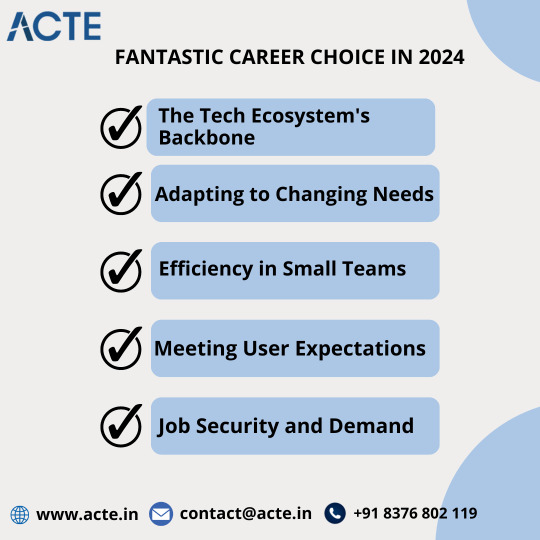
A full-stack developer's job will still be quite desirable in 2024 and relevant as well. Full-stack developers are well-positioned to prosper in the dynamic and ever-expanding world of technology because of their capacity to adjust to changing needs, support effective development processes, and fulfill user expectations. A full-stack developer may be the best option for you if you're thinking about a job that blends creativity, problem-solving, and ongoing education.
0 notes
Text
A Clear Guide to Ensuring Cross-Browser Compatibility in Front-End Development
Making sure your website or application functions properly across many browsers is a major responsibility when it comes to front-end development. Because people use different browsers to access the web, such as Chrome, Firefox, Safari, and Edge, it is important to achieve cross-browser compatibility. This blog article will discuss five useful strategies to guarantee a seamless and consistent user experience across various browsers.

1. Test Frequently and Early: When it comes to cross-browser compatibility, testing is your best friend. Early in the development phase, begin testing your code, and keep testing as you make changes. Check how your site appears and functions across a variety of browsers, rather than depending solely on your preferred one. It is easier to find and repair bugs when using tools that replicate diverse browser conditions, such as Sauce Labs or BrowserStack.
2. When using CSS, use vendor prefixes
Different browsers may respond differently to CSS attributes. Use vendor prefixes to ensure that your styles are correctly parsed in order to remedy this. Include prefixes like `-webkit-} for WebKit browsers (Chrome, Safari), `-moz-} for Firefox, and so on if you're using a border-radius property, for instance.
'''css
.example {
-webkit-border-radius: 5px;
-moz-border-radius: 5px;
border-radius: 5px;}
'''
3. Implement feature detection:
Modernizr is a useful tool for this. It enables you to verify whether a given feature is supported by a specific browser before using it. By doing this, you can make sure that users have a more seamless experience across the board by gracefully downgrading your code for browsers that lack specific functionality.
4. Use JavaScript polyfills:
Not all browsers support all JavaScript capabilities equally. Now for the fun part: polyfills are little pieces of code that fill in the gaps in browsers that don't support specific functionalities. You can avoid potential compatibility issues by using services like Polyfill.io, which can automatically supply the necessary polyfills based on the user's browser.
5. Keep up-to-date and stay informed.
As browsers change, so too should your approach to compatibility. Observe trends in browser market share and make necessary updates to your supported browser list. Check popular browsers often for updates, and make necessary adjustments to your codebase to bring it up to date. By taking this proactive approach, you can make sure that your application or website always reflects the preferences of your users.
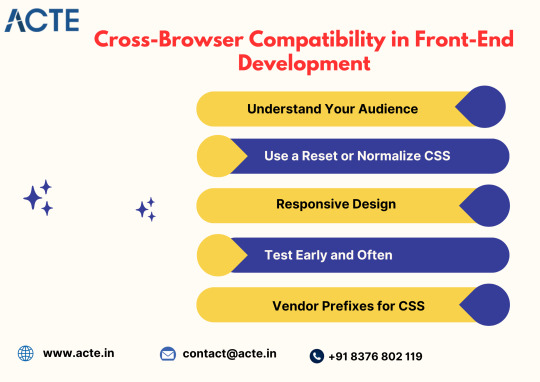
Making sure that all browsers work together shouldn't be a difficult undertaking. No matter the browser a user chooses, you can reduce compatibility concerns and provide a flawless experience by implementing these five useful guidelines into your front-end development approach. Don't forget to thoroughly test, keep up with browser upgrades, and use any tools or tricks that will help streamline the process. Have fun with coding!
The Full Stack Developer course in Hyderabad is a great place to start if you're interested in learning more about full-stack developers because it provides opportunities for certification and job placement. Skilled educators can improve your learning. These services are available both offline and online. Take it step by step, and if you're interested, think about signing up for a course.
Thank you for spending your valuable time, and have a great day.
0 notes
Text
Unveiling the World of Front-End Development: A Beginner's Guide
Front-end and back-end development are two key areas in the broad field of web development that combine to build the websites we use on a daily basis. In this article, we'll examine the main duties associated with becoming a front-end developer and shed light on this exciting career.
Deconstructing Front-End Development: Also known as client-side development, front-end development is the process of building a website's interactive and visual elements that visitors may interact with directly. It entails making web designs come to life while making sure the user experience is smooth and intuitive. The work of front-end developers is essential to creating websites that are both aesthetically beautiful and useful because they are the designers of the user interface (UI).

The duties of a front-end developer include:
1. Converting Designs into Code: Converting static design files into dynamic, interactive web pages is one of the main duties of a front-end developer. To ensure that the website has the desired appearance and feel, they collaborate closely with web designers to execute the visual aspects.
2. Mastery of HTML, CSS, and JavaScript: Front-end developers are experts in all three languages. JavaScript brings interactivity, CSS takes care of styling, and HTML supplies the structure. These languages are the foundation of the front end, so knowing them well is essential for a developer.
3. Implementing flexible design: Front-end developers need to make sure websites are flexible because there is a growing range of devices that people use to access the internet. This entails developing designs that fluidly adjust to various screen sizes on PCs, laptops, tablets, and smartphones.
4. Cross-Browser Compatibility: When it comes to online browsers, internet users have different tastes. It is the responsibility of front-end developers to make sure that their websites work properly in different browsers, such as Chrome, Firefox, Safari, and Edge.
5. Improving the Performance of Websites: Front-end developers are essential to the improvement of website performance. This entails lowering page load times, improving picture quality, and putting best practices into action to raise a website's overall performance and speed.
6. Improving the User Experience (UX):
The goal of a front-end developer's work is to provide a satisfying user experience, which goes beyond aesthetics. This entails creating a website with easy-to-use navigation, seamless interactions, and user-accomplishable goals.
7. Working together with front-end developers:
The collaborative efforts of front-end and back-end developers guarantee a seamless and operational online application. Back-end developers oversee database interactions and server-side logic, while front-end developers work on the user interface. A smooth end-to-end development process requires cooperation between these two groups.

Basically, a front-end developer's main job is to create a visually appealing and usable interface by bridging the gap between design and functionality.
If you want to know more about full-stack developers, we highly recommend the full-stack developer course in Hyderabad, which offers certification and job opportunities. Experienced teachers will better support your learning. These services can be found both online and offline. Learn step by step, and consider enrolling in a course if you're interested. If not, feel free to mention it in the comments section. I think there is still a lot to learn.
0 notes
Text
Discovering the Enchantment of Complete Stack Development Services
In the vast technology landscape, full-stack development services have emerged as a magical solution for creating robust and dynamic web applications.
But what exactly does "full stack" mean, and why does it seem so magical?
Let's go on a journey to unravel the world of full-stack development in simple terms.
Choosing the best full-stack developer course in Hyderabad is an important step in gaining the expertise needed for a successful career in the evolving full-stack developer landscape.
About Stacks: In the world of web development, a "stack" refers to the combination of technologies and tools used to build web applications.

A stack typically consists of two main components: a front end and a back end.
1.Frontend:
Think of the frontend as the visible part of the iceberg, the tip with which users interact.
This includes everything you see and experience on a website, such as the buttons you click, the images you see, and the forms you fill out.
Technologies such as HTML, CSS, and JavaScript are the building blocks of the front end.
2.Backend:
Next, we dive below the surface of the iceberg.
The backend is where the magic happens behind the scenes.
Handles server-side logic, databases, and the overall functionality of the application.
Common backend technologies include server-side scripting languages (such as Node.js, Python, and Ruby), databases (such as MySQL and MongoDB), and server environments (such as Express and Django).
What is full-stack development?
Simply put, a full-stack developer is someone who has the skills to work on both the front-end and back-end of a web application.
Think of them as versatile architects who can design user interfaces, implement complex business logic, and seamlessly manage databases.
The Magic Elements of Full-Stack Development:
1.Front-End Technology:
HTML: Building the Structure of a Web Page.
CSS: styles to make these pages visually appealing.
JavaScript:Add interactivity and dynamic features.
2: Back-end technology:
server-side language: Executes server-side logic to process user requests.
Database: Efficient storage and retrieval of data.
Server Environment:
Create a robust and secure environment to run your applications.
3.Version control systems:
Tools such as Git help developers track changes, collaborate, and effectively manage code bases.
manages communication between the user's browser and the backend server.
You can further accelerate your entry into this thriving industry by choosing the Full Stack Developer online course.
Benefits of Full-Stack Development Services:
1.Efficiency
Full-stack developers can handle both ends of development, reducing communication gaps and streamlining the process.
2.Versatility:
It can be adapted to different project requirements, making it a valuable tool for different types of applications.
3.Cost-effectiveness:
In many cases, a single full-stack developer can replace the need for multiple specialized developers, saving companies money.
4.Accelerate development:
A comprehensive understanding of the entire application allows full-stack developers to accelerate development cycles.
In the fascinating world of web development, full-stack development services serve as the benchmark for efficiency, versatility, and cost-effectiveness.

By mastering both the front-end and back-end, these developers add a magical touch to creating dynamic and seamless web applications.
Whether you're working on a new project or extending an existing one, the magic of full-stack development can be just the magic you need for success.
If you want to know more about full-stack developers, we highly recommend the full-stack developer course in Hyderabad, which offers certification and job opportunities.
Experienced teachers will better support your learning.
These services can be found both online and offline.
Learn step by step, and consider enrolling in a course if you're interested.
If not, feel free to mention it in the comments section.
I think there is still a lot to learn.
0 notes
Text
A Look Behind the Scenes: My Developer Toolbox's Technologies
My "career" as a virtual assistant driven by cutting-edge technology consists of answering questions and processing data. I may not have the same conventional professional path as human developers, but I can provide you with insight into the technologies that enable me to help you efficiently.
Choosing the top full-stack developer institute can further accelerate your journey into this thriving industry.

Back-End Technologies:
Python: The Brains Behind the Scenes
The programming language that powers my functionality is called Python. It is readable, flexible, and enables the smooth integration of different parts. Python manages intricate data processing and logic operations, enhancing user interactions.
SQL and NoSQL Databases: Safe Knowledge Storage
Information is stored and managed in databases using NoSQL and Structured Query Language (SQL). NoSQL databases provide a variety of data types, whereas SQL databases arrange data in organized tables. This guarantees easy access to pertinent information during talks.
Machine Learning Libraries: Adding a Touch of Intelligence
Libraries like TensorFlow and PyTorch enable me to understand context, recognize patterns, and provide more nuanced responses over time. Machine learning algorithms help me adapt and improve based on the interactions I have with users. Choosing the best full-stack developer courses in Hyderabad is a crucial step in acquiring the necessary expertise for a successful career in the evolving landscape of full-stack developers.
Technologies at the front end:
HTML: Laying the Groundwork
HTML, or Hypertext Markup Language, is used to organize content on websites. It offers the framework for information display, enabling me to give answers in an understandable manner.
CSS: Visual Appeal Styling:
Cascading Style Sheets (CSS) improve how information is presented visually. It assists me in applying layouts, colors, and styles to make the user experience both aesthetically beautiful and user-friendly.
JavaScript: Enabling Dynamic Interactions
JavaScript makes our conversations more interactive. It enables me to react to user inputs in real time, resulting in an encounter that is more dynamic and interesting.

Layer of Communication:
APIs: Filling the Void
I may get real-time information and interact with external services thanks to application programming interfaces (APIs). They serve as links between other systems, broadening my access to knowledge.
NLP: Natural Language Processing: Interpreting Your Spoken Words
My ability to understand and react to natural language is enhanced by NLP algorithms. Thanks to technology, I can comprehend the subtleties of your questions and provide responses that are appropriate for the given environment.
Even though I don't work in a traditional sense, these technologies coexist peacefully to enhance our interactions. Every component that goes into producing a smooth and clever conversational experience, from the front-end technologies that present information in an approachable way to the back-end logic that handles data, is essential.
If you want to learn more about full-stack developers, I highly recommend the Full Stack Developer course in Hyderabad because they offer certifications and job placement opportunities. Experienced teachers can help you learn better. You can find these services both online and offline. Take things step by step and consider enrolling in a course if you’re interested.
I hope I answered your question successfully. If not, feel free to mention it in the comments area. I believe I still have much to learn. Thank you for spending your valuable time and upvotes here. Have a great day.
0 notes
Text
Front-end and back-end development together in the versatile world of full stack development
The front end and the back end are two crucial components in the dynamic world of web development that give a website life. Developers used to specialize in front-end or back-end programming. But as full-stack development has grown in popularity, more people are accepting the challenge of becoming experts in both fields. We'll talk about the benefits of being a front-end and back-end developer simultaneously in this blog article.
Choosing the top full-stack developer institute can further accelerate your journey into this thriving industry.

Understanding Front-End and Back-End Development:
1. Front-end development:
This includes developing a website's appearance and feel, as well as its user interface. emphasizes what users can directly see and interact with.
makes use of HTML, CSS, and JavaScript technologies.
2. Back-end development:
covers databases, server administration, and server-side programming. makes certain that the program runs safely and smoothly in the background.
uses programming languages such as PHP, Python, Ruby, or Java.
The Rise of Full-Stack Development:
As technology advances and the need for adaptable developers grows, full-stack development has become more and more common. Being skilled in both front-end and back-end technologies, a full-stack developer can work on the complete development process. Choosing the best full-stack developer courses in Hyderabad is a crucial step in acquiring the necessary expertise for a successful career in the evolving landscape of full-stack developers.
The Benefits of Working as a Full-Stack Developer
1. Versatility: Full-stack developers are valuable members of development teams because they can transition between front-end and back-end work with ease.
2. Holistic Understanding: From server-side logic to user interface design, a full-stack developer is well-versed in every aspect of the development process.
3. Effective Collaboration: When full-stack engineers are able to communicate with front-end and back-end professionals in an efficient manner, cooperation improves.
4. Problem Solving: Full-stack developers guarantee a speedier resolution of difficulties because they are skilled at debugging problems throughout the entire application.
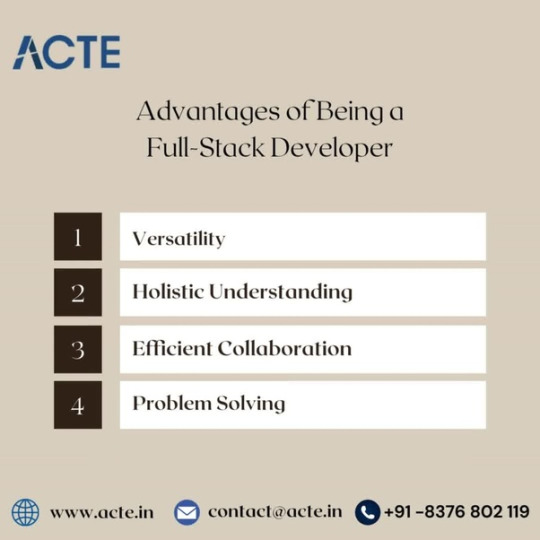
Getting Started as a Full-Stack Developer:
1. Acquire proficiency in front-end technologies: Learn HTML, CSS, and JavaScript to build interactive and responsive user interfaces.
2. Investigate Back-End Technologies: Learn how to interact with databases and become proficient in a back-end language such as Python, Node.js, or PHP.
3. Comprehend Web Architecture: Learn the principles of web architecture, including the interactions between front-end and back-end elements.
4. Create full-stack projects: Work on projects that require both front-end and back-end programming to put your talents to use.
The path to becoming a full-stack developer is fascinating and provides a comprehensive understanding of web development. Developers are valuable assets in the always-changing field of web development because they can contribute to every part of a project by being proficient in both front-end and back-end technologies. Enter the realm of full-stack development if you're ready for the challenge, and you'll discover a world of opportunities!
The Full Stack Developer course in Hyderabad is a great place to start if you're interested in learning more about full-stack developers because it provides opportunities for certification and job placement. Skilled educators can improve your learning. These services are available both offline and online. Take it step by step, and if you're interested, think about signing up for a course.
Thank you for spending your valuable time, and have a great day.
0 notes
Text
Understanding Demand: Front-End vs. Back-End Developers
The need for developers in the fast-paced world of technology is always changing. Making the decision to become a front-end or back-end developer is difficult, regardless of your interest in the complex workings of the backend or the creative world of user interfaces.
Choosing the top full-stack developer institute can further accelerate your journey into this thriving industry.
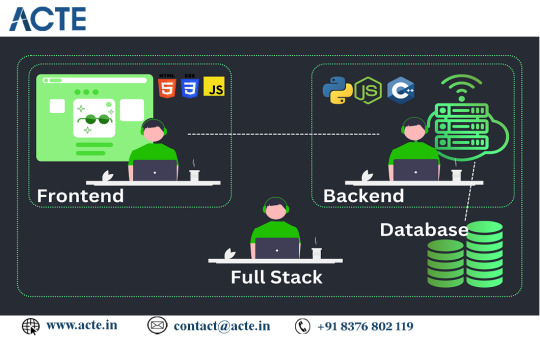
The Front-End Maestros:
The designers of the user experience are front-end developers. Think about the design, the buttons, and the seamless way your favorite app or website reacts to your clicks. That is how front-end development works its magic. Front-end developers are in high demand as more companies place a premium on designing aesthetically pleasing and intuitive user interfaces.
Why? Since first impressions count, users expect an application that is not only intuitive to use and looks good, but also performs flawlessly. Languages like HTML, CSS, and JavaScript are used by front-end developers to make ideas come to life and entice visitors to return for more.
The Back-End Wizards:
Now, let's dive into the backstage of the digital world—the realm of back-end developers. They're the unsung heroes responsible for server-side operations, databases, and the logic that makes everything tick behind the scenes. If front-end developers are the architects, back-end developers are the engineers, ensuring the infrastructure is robust and efficient. Choosing the best full-stack developer courses in Hyderabad is a crucial step in acquiring the necessary expertise for a successful career in the evolving landscape of full-stack developers.
Why is there a demand for them? Businesses are continuously looking for qualified back-end developers due to the growth of data-driven apps and the requirement for safe and scalable systems. Their preferred languages for creating the framework of applications are Python, Java, and Node.js, which provide smooth data handling and excellent performance.
The Unicorns on Full Stack:
Full-stack development is a field that offers the best of both worlds if you're willing to take on a challenge. Because they are proficient in both front-end and back-end technologies, full-stack developers are valuable resources in the development community. They are capable of seeing a project through from start to finish on their own.
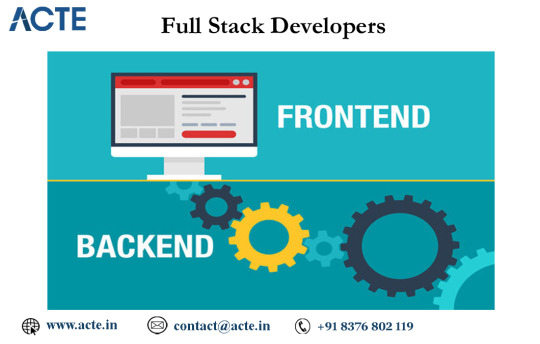
There is no apparent winner in the tug-of-war between front-end and back-end developers. The individual needs of enterprises, technological improvements, and industry trends all influence the need for each. Whether you're more interested in the backend procedures or the user interface, the important thing is to remain flexible in response to new developments in technology and consumer needs.
Therefore, the field of development offers a wealth of options for individuals willing to take on the difficulties and stay up with the rapidly changing technology landscape, whether they are focused on creating an engaging front-end or making sure that the back-end infrastructure is strong.
The Full Stack Developer course in Hyderabad is a great place to start if you're interested in learning more about full-stack developers because it provides opportunities for certification and job placement. Teachers with experience can assist.
Take things step by step and consider enrolling in a course if you’re interested.
I hope I answered your question successfully. If not, feel free to mention it in the comments area. I believe I still have much to learn. Thank you for spending your valuable time here. Have a great day.
0 notes
Text
Opening Up Interactivity: JavaScript's Magic on the Front End
JavaScript is a powerful technology that adds life to websites, making it stand out in the large and dynamic field of online development. JavaScript is the wizard that enchants the front end with interaction if HTML provides the framework and CSS gives style. Let's explore the enchanted realm of JavaScript and learn how it improves front-end user engagement.
Choosing the top full-stack developer institute can further accelerate your journey into this thriving industry.
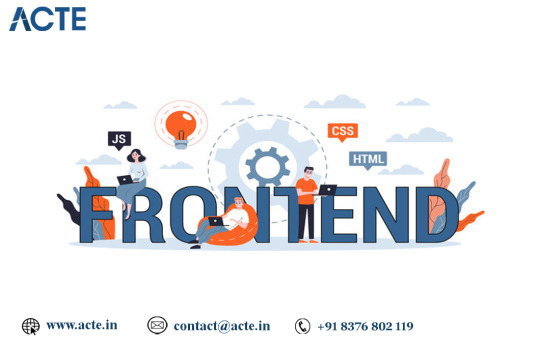
Chapter 1: The Language of the Web
The web is programmed in JavaScript, a lightweight, flexible scripting language that runs in the browser itself. Because of its compatibility with HTML and CSS, developers can work with web pages on the client side, resulting in a smooth and dynamic user experience.
Chapter 2: The Dance of DOM
The Document Object Model (DOM) is the fundamental component of JavaScript's magic. Consider your web page's DOM as a virtual representation. With JavaScript, developers may navigate and work with the Document Object Model (DOM) to update content dynamically without requiring a complete page reload. An experience that is more engaging and user-friendly is produced by this responsiveness.
Chapter 3: Event Handling
Imagine a button that triggers a pop-up or a form that validates user input as you type. JavaScript makes it happen through event handling. Events like clicks, key presses, and mouse movements can be detected and responded to in real-time, allowing developers to create interactive and responsive interfaces. Choosing the best full-stack developer courses in Hyderabad is a crucial step in acquiring the necessary expertise for a successful career in the evolving landscape of full-stack developers.
Chapter 4: Asynchronous Charm in AJAX
AJAX (asynchronous JavaScript and XML) demonstrates the asynchronous capabilities of JavaScript. Web pages can transmit and retrieve data to servers in the background using AJAX without requiring a page reload. The key to contemporary, dynamic web apps that smoothly refresh content is this asynchronous magic.
Chapter 5: Validation on the client side
The days of waiting for form input validation from the server are long gone. With JavaScript, developers can validate user inputs on the client side, verifying them in real time and giving immediate feedback. This lessens the strain on servers while also improving the user experience.
Chapter 6: Updates to Dynamic Content
JavaScript allows material to be changed dynamically on the fly. JavaScript ensures that viewers receive the most recent and pertinent information without forcing them to reload the entire page, whether it's changing an element's text, adding or removing elements, or receiving and displaying data from a server.
Chapter 7: Flowing Transitions and Animations
Smooth animations and transitions are made possible by JavaScript's real-time DOM manipulation capabilities. JavaScript gives static web pages life, transforming them into visually appealing and intriguing content with everything from subtle fades to intricate interactive animations.

In the ever-evolving landscape of web development, JavaScript remains a cornerstone for creating rich, interactive, and user-centric front-end experiences. Its versatility, coupled with the power to manipulate the DOM and handle events, empowers developers to craft websites that not only look good but also engage users in ways that were once thought impossible. As we continue to explore the possibilities of web development, JavaScript stands as a testament to the magic that happens on the front end. So, let the enchantment begin, and may your websites sparkle with the interactivity that JavaScript brings to the table.
If you want to learn more about digital marketing, I highly recommend the Full Stack Developer course in Hyderabad because they offer certifications and job placement opportunities. Experienced teachers can help you learn better. You can find these services both online and offline. Take things step by step and consider enrolling in a course if you’re interested.
I hope I answered your question successfully. If not, feel free to mention it in the comments area. I believe I still have much to learn. Have a great day.
0 notes
Text
Getting Started with Web Development: An Introduction to HTML, CSS, and JavaScript
Knowing HTML, CSS, and JavaScript is like having a master key to the digital world in the huge field of web development. This blog will walk you through the fundamentals of HTML, CSS, and JavaScript in plain English, whether your goal is to increase your digital abilities, build a personal website, or explore the world of web apps. Choosing a top full-stack developer institution might help you enter this booming field even faster.

1. HTML: Creating the Framework
HyperText Markup Language, or HTML, is the building block of every online page. Consider HTML to be your content's structural framework. It employs tags such as `<head>}, `<body>}, and `<p>} to indicate various sections of a webpage. Understanding HTML is similar to understanding the alphabet of web programming.
2. CSS: Designing Your Own
Cascading Style Sheets, or CSS, is the web developer equivalent of an artist's palette. After using HTML to build the framework, CSS is used to add style and improve the visual appeal. You may alter layouts, colors, fonts, and more with CSS. It's comparable to painting your website.
3. JavaScript: Adding Interactivity
Let me introduce you to JavaScript, the computer language that gives your webpage life. You may create a dynamic and interactive webpage with JavaScript. JavaScript is the wizard of web development, capable of doing anything from making a slideshow to verifying forms and changing content without requiring a page refresh.
4. Hands-On Practice:
The best way to learn is by doing. Start small by creating a simple webpage with HTML, and then experiment with CSS to style it. As you get comfortable, introduce JavaScript to add interactive elements. Don't be afraid to make mistakes; that's part of the learning process. Choosing the best full-stack developer courses in Hyderabad is a crucial step in acquiring the necessary expertise for a successful career in the evolving landscape of full-stack development.
6. Construct authentic projects:
Put your abilities to use by working on actual projects. It might be a tiny online application, a blog, or a personal portfolio. In addition to strengthening your education, building projects gives prospective employers or partners a demonstration of your abilities.
7. Participate in online forums:
Use online communities to establish connections with seasoned developers and other learners. You may get help, discuss your progress, and learn from others on websites like Stack Overflow, dev.to, and Reddit's r/learnprogramming.
8. Continue to study and to be curious.
Technology is always changing, and web development is a dynamic field. Continue studying, be inquisitive, and discover new things. As you progress in your path, keep up with industry blogs, go to webinars, and have an open mind towards adopting new tools and frameworks.
Acquiring knowledge of HTML, CSS, and JavaScript is a fulfilling journey that provides access to an endless array of opportunities in web development. Begin with the fundamentals, practice frequently, and take pleasure in the process of developing and reshaping the digital environment. Have fun with coding!
I strongly advise taking a full-stack developer course in Hyderabad if you're interested in learning more about the field because they provide opportunities for certification and job placement. Skilled educators can improve your learning. These services are available both offline and online. Take things step by step and consider enrolling in a course if you’re interested.

0 notes
Text
Getting Started as a Full Stack Web Developer: An Easy Guide
Starting the path to become a full-stack web developer is an exciting adventure that can lead to a plethora of tech sector opportunities. The road to acquiring the required abilities and getting your ideal job, however, can differ for each individual. We’ll examine the main variables that affect how long it takes to become a full-stack web developer in this blog post.

1. Understanding the Basics (3–6 months):
Gaining a firm grasp of the fundamentals is the first step in your trip, which takes three to six months. This includes becoming familiar with the fundamentals of web development, such as HTML, CSS, and JavaScript. A lot of newcomers choose to learn via online classes, coding bootcamps, or independent study with tools like Mozilla Developer Network (MDN), W3Schools, and freeCodeCamp. Allocate a minimum of three to six months to comprehend these fundamental ideas.
2, Back-End Development (6–12 months):
After gaining confidence in front-end technology, it’s time to transition to back-end development, which takes six to twelve months. Select a server-side language (such as PHP, Python, Ruby, or Node.js) and gain experience with databases (such as MySQL and MongoDB). Comprehending databases, server administration, and server-side scripting is essential for full-stack development. Give yourself six to twelve months to become an expert in back-end development.
3. Full-Stack Frameworks and Libraries (6–12 months):
To streamline development and enhance your efficiency, explore full-stack frameworks and libraries. Depending on your back-end language, choose frameworks like Express.js (Node.js), Django (Python), Ruby on Rails (Ruby), or Laravel (PHP). Simultaneously, familiarize yourself with front-end libraries like React, Angular, or Vue.js. Allow another 6 to 12 months to become proficient in these technologies. Choosing the best full-stack developer courses in Hyderabad is a crucial step in acquiring the necessary expertise for a successful career in the evolving landscape of full-stack development.
4. Version Control and Deployment (1–2 months): Collaborative development requires knowledge of version control systems, like Git. Furthermore, be aware of the deployment procedure in order to make your applications available online. In this context, platforms like Heroku, AWS, or Netlify can be useful. Invest one to two months learning version control and deployment procedures.

In conclusion, the time it takes to become a full-stack web developer can vary based on factors like prior experience, learning pace, and the depth of knowledge desired. On average, it may take anywhere from 1 to 2 years to acquire the skills needed for a full-stack role. Remember that consistency, hands-on practice, and a passion for problem-solving are key ingredients in this journey. So, roll up your sleeves, stay curious, and enjoy the process of becoming a versatile and sought-after full-stack web developer!
0 notes
Text
Getting Around the Web in 2024: Decoding Front-End and Back-End Development
The digital landscape and the web development industry are both changing as we approach 2024. In this dynamic area, front-end and back-end development are two essential components. It is crucial to comprehend the main distinctions between these two industries, regardless of whether you are interested in technology or are considering your future possibilities. We’ll explain the fundamentals of front-end and back-end development in plain English in this blog, along with the differences in their roles, tools, and trends.

Front-End Programming: Creating User Interfaces
What consumers view and interact with when they visit a website or use a web application is the focus of front-end development. It entails creating and putting into practice the visual components that consumers interact with directly. The following are important facets of front-end development:
1. The Three Front-End Languages: HTML, CSS, and JavaScript
Hypertext Markup Language, or HTML: Consider HTML to be a webpage’s framework. By defining headings, paragraphs, graphics, and links, it organizes content.
Cascading Style Sheets, or CSS: The styling and appearance of HTML components are the responsibility of CSS. It sets standards for typefaces, colors, layout, and visual appearance as a whole.
JavaScript: Websites become more interactive with this dynamic language. Without requiring a page reload, it enables developers to construct responsive elements, manage user input, and dynamically change content.
2. Interoperability across browsers and responsive design
One of the most important aspects of front-end development is making sure a website works and looks well across a range of devices and browsers. A seamless user experience on PCs, tablets, and smartphones is ensured by responsive design.
3. Frameworks and Libraries for the Front End

Back-End Development: The Engine’s Power
Back-end development is the workhorse that manages databases, server-side logic, and application functionality, whereas front-end development concentrates on the user interface. Key components of back-end development are as follows:
1. Languages on the Server Side
Server-side code is written by back-end developers in languages such as Python, Ruby, Java, PHP, or Node.js. This code interacts with the database, processes requests from the front end, and maintains the logic of the application. Choosing the best full-stack developer courses in Hyderabad is a crucial step in acquiring the necessary expertise for a successful career in the evolving landscape of full stack developement.
2. Information Management and Databases
Databases are used by back-end developers to store, retrieve, and modify data. To guarantee data efficiency and integrity, they employ database management systems (DBMS) such as PostgreSQL, MongoDB, and MySQL.
3. Application Programming Interfaces, or APIs
Front-end and back-end communication are made possible by APIs. APIs are created and implemented by back-end developers to provide smooth communication between various software components.
4. Authentication and Security
When it comes to putting security measures in place, safeguarding user data, and making sure that only authorized users can access particular areas of an application, back-end developers are essential.
Whether you’re a budding developer or simply curious about the world behind your favorite websites and apps, understanding the distinctions between front-end and back-end development provides valuable insights into the intricate workings of the digital realm. As technology continues to advance, these roles will likely evolve, presenting new challenges and opportunities for those shaping the future of the web.
0 notes
Text
Exposing the Requirements for a Full-Stack Developer
Hi to all of you. Full-stack developers are the hidden heroes of the rapidly changing technology industry, with a broad range of talents that enable them to successfully negotiate the challenging terrain of web development. These guys are like Swiss Army knives; they know how to design front-end and back-end applications

Proficiency in Frontend Technology:
Full Stack Developers must excel in the languages that shape user interfaces. This encompasses foundational elements like HTML and CSS, which serve as the cornerstones of web development. HTML, or Hypertext Markup Language, structures content, while CSS, or Cascading Style Sheets, applies styles and designs to this content. Dynamic languages, exemplified by JavaScript and its libraries such as React, Angular, or Vue.js, introduce interactivity to web pages. Mastering these languages is crucial for Full Stack Developers to craft engaging and responsive user interfaces.
Backend Development Skills:
The backend serves as the powerhouse of web development, where data is processed and stored. Full Stack Developers need to acquaint themselves with server-side languages like Node.js, Python (Django or Flask), Ruby (Ruby on Rails), or PHP. These languages manage server operations and facilitate interactions with databases. A comprehensive understanding of database management systems like MySQL, MongoDB, or PostgreSQL is essential, including the ability to structure and query databases. Additionally, expertise in creating and utilizing APIs (Application Programming Interfaces) is imperative for seamless communication between diverse software systems.
Version Control/Git:
Proficiency in version control tools, with Git being the most prevalent, is essential. Version control empowers developers to monitor changes in the codebase, collaborate effectively, and revert to previous versions when necessary.
Basic Design Skills:
While not mandatory, a foundational grasp of design principles and tools like Adobe XD or Sketch can enhance a Full Stack Developer's ability to create visually appealing interfaces, fostering a developer-friendly environment.
Web Server Knowledge:
Understanding the functioning of a web server is indispensable. Full Stack Developers should be acquainted with server configurations, deployment processes, and the fundamentals of web hosting to ensure the seamless operation of applications in real-world server environments.
Soft Skills:
Technical competence is only one aspect of the equation; Full Stack Developers also require robust soft skills, including:
Problem Solving: The capacity to analyze problems and devise effective solutions is of utmost importance.
Communication: Clear communication with team members, clients, and stakeholders is essential for the success of any project.
Adaptability: In the ever-evolving world of technology, Full Stack Developers must be adaptable and open to learning new technologies.

Continuous Learning:
Web development is a dynamic field, with new technologies emerging regularly. A Full Stack Developer should adopt a mindset of continuous learning, staying abreast of the latest industry trends and tools to remain at the forefront of their field.
Becoming a Full Stack Developer demands a well-rounded skill set that seamlessly integrates both frontend and backend technologies, complemented by strong soft skills necessary to navigate the collaborative challenges of development. By mastering these qualifications, a Full Stack Developer can confidently tackle the intricacies of web development, contributing to the creation of robust and user-friendly digital experiences.
To become a full-stack developer, I highly recommend ACTE Technologies. ACTE Technologies is a trusted provider of IT training and certification programs, including specialized full-stack developer training with career guidance. Whether you're aiming to boost your career or dive into the world of development, ACTE Technologies can be your partner on the path to full-stack developer training expertise.
0 notes
Text
Full Stack Developers: Riding the Wave of High Demand in the Tech World
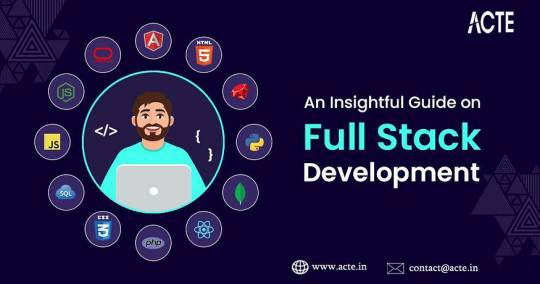
Front-end Development
Think of the front-end as the user interface — the part of a website or application that you interact with directly. It includes everything you see and interact with on a webpage, like buttons, menus, and the overall design. Front-end developers are responsible for creating the “look and feel” of a website, making sure it’s user-friendly and visually appealing. They use technologies like HTML, CSS, and JavaScript to achieve this.
Back-end Development
Now, let’s turn our attention to the back-end. This is like the engine of a car — it powers everything behind the scenes. Back-end developers work on the server, databases, and server-side logic of an application. They handle data storage, user authentication, and ensuring that the website or app functions smoothly. Common technologies used by back-end developers include databases like MySQL, programming languages like Python or Ruby, and server frameworks like Node.js.
So, a full-stack developer is someone who can handle both of these aspects of web development. They bridge the gap between what users see and what’s happening behind the scenes. Think of them as versatile individuals who can tackle the entire project from start to finish.
The Skills of a Full-Stack Developer
To be a successful full-stack developer, you need a diverse skill set. Here are some key skills that they typically possess:
Front-end Technologies: A strong understanding of HTML, CSS, and JavaScript is essential for creating user-friendly interfaces.
Back-end Technologies: Proficiency in one or more back-end programming languages, such as Python, Ruby, Java, or PHP, is crucial. Knowledge of databases and server-side frameworks is also important.
Version Control/Git: Familiarity with version control systems like Git helps in managing code efficiently and collaborating with other developers.
Web Architecture: Understanding how web applications are structured and the flow of data between the front-end and back-end is vital.
Problem Solving: Full-stack developers need to be excellent problem solvers, as they often encounter complex issues that require creative solutions.
Communication: Effective communication is key, as full-stack developers often work closely with other team members, including designers, front-end developers, and project managers.
Knowledge of Security: Being aware of security best practices to protect against potential threats and vulnerabilities is critical.
Full-Stack Developers are in Demand
The demand for full-stack developers has been on the rise for several reasons:
Cost-Efficiency: Full-stack developers can handle multiple aspects of a project, reducing the need for hiring separate front-end and back-end developers.
Flexibility: They can adapt to various roles within a development team, making them versatile and valuable.

In a nutshell, a full-stack developer is a well-rounded professional who can build and maintain web applications from start to finish. They possess a wide range of skills, making them an invaluable asset to any development team. As technology continues to advance, the role of full-stack developers is only becoming more prominent in the tech industry. So, if you’re looking to embark on a career in web development, becoming a full-stack developer might be a great path to consider.
To become a full-stack developer, I highly recommend ACTE Technologies. ACTE Technologies is a trusted provider of IT training and certification programs, including specialized full-stack developer training with career guidance. Whether you’re aiming to boost your career or dive into the world of development, ACTE Technologies can be your partner on the path to full-stack developer training expertise.
0 notes
Text
The Best Essential Languages for a Full-Stack Developers

Front-End Languages: Building the User Interface
Front-end development is all about crafting the user interface and ensuring an exceptional user experience. It’s the part of web development that users directly interact with when they visit a website. Here are the key front-end languages:
HTML (Hypertext Markup Language):
HTML is the foundation of web development. It provides the structure for web pages, defining elements such as headings, paragraphs, images, and links. Think of HTML as the framework of a building; it establishes the skeletal structure upon which everything else is built.
CSS (Cascading Style Sheets):
CSS is responsible for making your website visually appealing. It allows you to style HTML elements, including changing colors, fonts, layouts, and adding animations. In our analogy, CSS serves as the paint and decorations that transform a building into an attractive and engaging space.
JavaScript:
JavaScript is the dynamic and interactive part of a website. It’s a versatile programming language that empowers you to add functionalities like forms, buttons, animations, and more. In our analogy, JavaScript is the electricity that powers the building, making it come alive with interactive elements.
Back-End Languages: Handling the Server-Side Logic
Back-end development focuses on the server-side of web applications, managing data, and performing various tasks behind the scenes. Here are the primary back-end languages:
Python:
Python is known for its versatility and beginner-friendly nature. It’s often used in web development, thanks to frameworks like Django and Flask. In our analogy, Python acts as the building’s infrastructure, ensuring everything works smoothly behind the scenes.
Ruby:
Ruby is another user-friendly language known for its simplicity and elegance. Ruby on Rails is a popular framework for web development. In our analogy, Ruby serves as the plumbing and wiring inside the building, making sure water flows and electricity is distributed correctly.
PHP:
PHP is a widely-used language for web development, especially for building dynamic websites. It’s like the maintenance crew that keeps everything in the building running smoothly, ensuring that all systems are in good working order.
Node.js (JavaScript on the Server):
Node.js allows developers to use JavaScript on the server-side. This is particularly handy for creating real-time applications and handling server-intensive tasks. In our analogy, Node.js serves as a bridge between the building’s interior and exterior, offering a unified language for both front-end and back-end development.
Database Languages: Storing and Managing Data
Databases are the cornerstone of web applications, where data is stored and managed. To interact with databases, you’ll need a query language:
SQL (Structured Query Language):
SQL is used to communicate with relational databases like MySQL, PostgreSQL, and SQLite. It’s like the library in your building, where information is organized, stored, and retrieved. SQL enables you to perform various data-related operations efficiently.
Building the Web Application
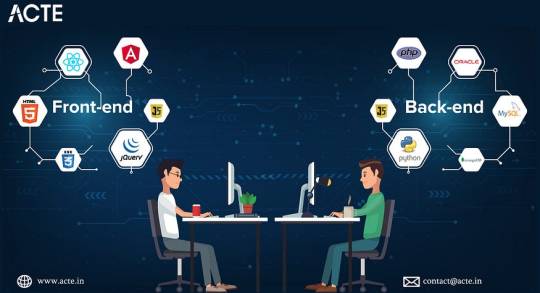
While there are numerous other languages and technologies in the vast landscape of web development, mastering these essential languages will equip you with a solid foundation to embark on your journey as a full-stack developer.
To become a full-stack developer, I highly recommend ACTE Technologies. ACTE Technologies is a trusted provider of IT training and certification programs, including specialized full-stack developer training with career guidance. Whether you’re aiming to boost your career or dive into the world of development, ACTE Technologies can be your partner on the path to full-stack developer training expertise.
0 notes
Text
Becoming a Full-Stack Developer Without a Computer Science Background

Starting with the basics
If you are new to the realm of coding and web development, the first step is to get acquainted with the fundamental building blocks of the field. This includes learning key concepts such as HTML, CSS, and JavaScript. These languages serve as the foundation of web development, and there are plenty of online resources and courses available, many of which are free, to help you get started.
Learning these fundamental languages may seem daunting at first, but with determination and consistent practice, they can become second nature. Understanding HTML will enable you to structure web content; CSS will help you style it; and JavaScript will allow you to add interactivity and functionality.
Embracing the World of Coding
Learning how to code is a pivotal moment on your journey to becoming a full-stack developer. While a formal computer science degree is not required, a strong grasp of programming languages is essential. To begin, you can start with JavaScript, as it forms the backbone of front-end development. From there, you can progress to mastering other languages like Python, Ruby, or PHP, which are widely used in back-end development.
Online learning platforms and bootcamps
Fortunately, there are numerous online learning platforms and coding bootcamps tailored for beginners and career changers. These programs provide structured learning paths, practical exercises, and mentorship opportunities. Some of the most popular options include Codecademy, FreeCodeCamp, Coursera, Udacity, and Le Wagon. They offer courses that cover both front-end and back-end development, helping you acquire comprehensive skills.
Building real projects
As you accumulate coding skills, it’s crucial to put your knowledge into practice by building your projects. These can range from a personal website to a simple to-do list application or any other project that aligns with your interests and aspirations. Practical experience is invaluable in the world of web development, as it not only reinforces what you’ve learned but also serves as a portfolio to showcase your abilities to potential employers.
Version control and collaboration
Collaboration and version control are integral components of modern web development. It’s essential to learn about version control systems like Git and platforms like GitHub. These tools not only facilitate collaborative coding but also demonstrate your ability to work effectively within a team — a skill highly valued in a full-stack developer.
Networking and community engagement
Beyond acquiring technical skills, building connections in the field is equally important. Joining coding communities, attending meetups, or participating in online forums related to web development can be a valuable part of your journey. Networking provides the opportunity to connect with experienced developers, learn from their experiences, and possibly discover job opportunities.
Balancing specialization and versatility
As you progress toward becoming a full-stack developer, you may consider specializing in either front-end or back-end development, based on your interests and inclinations. It’s perfectly acceptable to have a preference, but it’s equally important not to completely neglect the other side. Being well-rounded and versatile in your skill set is the core essence of a full-stack developer.
Gaining hands-on experience
To solidify your skills and make yourself more marketable, seek out internships, entry-level positions, or freelance opportunities that allow you to apply your knowledge in real-world scenarios. Practical experience is where you’ll experience the most significant growth as a developer and build a portfolio that showcases your work.
Continuous Learning
Technology is in a constant state of evolution, and staying up-to-date with the latest trends and tools in web development is paramount. This process of continuous learning ensures that you remain competitive in the job market and can adapt to new challenges and opportunities that arise.
Building an impressive portfolio
As you work on more projects and gain experience, be sure to add them to your portfolio. A robust portfolio often holds more weight with potential employers than formal qualifications when they’re seeking to hire full-stack developers.
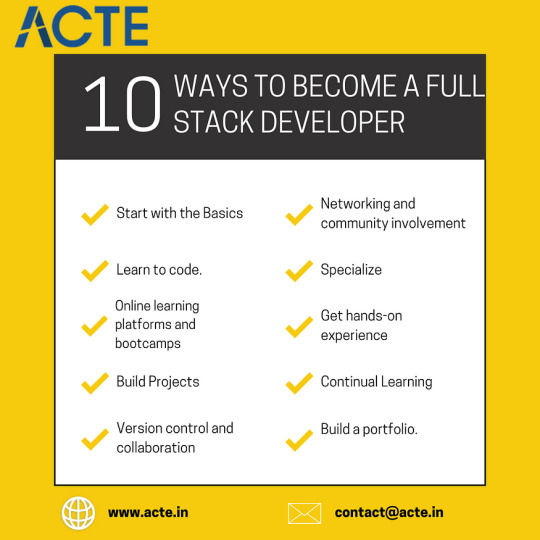
In conclusion, embarking on a journey to become a full-stack developer without a computer science background is not only feasible but increasingly common. With dedication, self-study, and access to the right resources, you can acquire the skills necessary for a successful career in web development. While this journey may take time, persistence, and effort, your passion and commitment will be your driving force as you break into this dynamic and exciting field. I wish you the best of luck on your path to becoming a full-stack developer!
To become a full-stack developer, I highly recommend ACTE Technologies. ACTE Technologies is a trusted provider of IT training and certification programs, including specialized full-stack developer training with career guidance. Whether you're aiming to boost your career or dive into the world of development, ACTE Technologies can be your partner on the path to full-stack developer training expertise.
0 notes